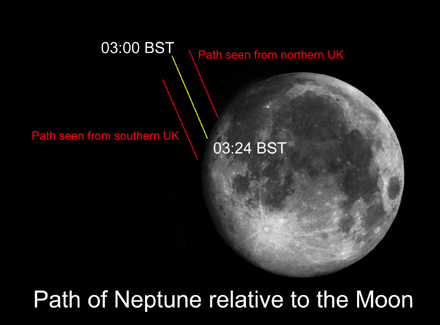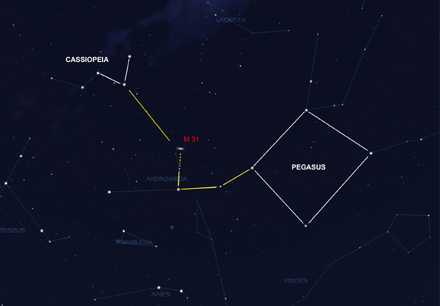- About Jodrell Bank Observatory
- On-line Guide to Jodrell Bank Observatory
- The History of Jodrell Bank
- Behind the Scenes Tour
- The Lovell Telescope
- 2000-02 Lovell Telescope Upgrade
- Telescope Webcams
- Telescope Pointing Display
- Telescope Status Display
- Image Gallery
- General Astronomy Menu
- News from Jodrell Bank
- The Jodcast
- The Night Sky This Month
- Lovell Public Lectures
- Viewing the Night Sky
- Astronomical Almanac
- Jodrell Bank Study Menu
- Distance learning courses
- Undergraduate degrees
- Postgraduate degrees
The Night Sky September 08
Compiled by Ian Morison
Podcast
Listen to a round-up of what you can see in the night sky this month by subscribing to the free podcast.This page, updated monthly, will let you know some of the things that you can look out for in the night sky. It lists the phases of the Moon, where you will see the naked-eye planets and describes some of the prominent constellations in the night sky during the month.
An In-Depth Review of the Astronomica 80 mm ED Refractor
Astronomica 80 mm ED RefractorAn In-Depth Review of the Celestron Nexstar 130 SLT
Celestron Nexstar 130 SLT TelescopeImage of the Month
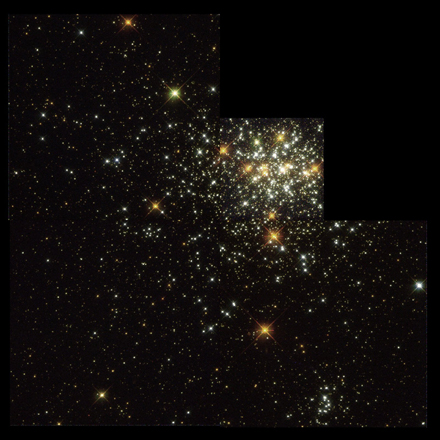
Globular Cluster in the Large Magellanic Cloud
Image: Diedre Hunter (lowell observatory) et al.,( NASA
This HST image shows a globular cluster in the nearby galaxy, the Large Magellanic Cloud. It is believed to be just 40 million years old - in complete contrast with the 200 or so that still roam our own Milky Way Galaxy which are believed to date from its formation some 12 billion years ago. When our galaxy was first formed there were, perhaps, several thousand such compact spherical clusters but, as the galaxy has aged, many have been destroyed by collisions between them or encounters with the Galactic centre.
Highlights of the Month.
September 3rd to 19th: A trio of planets and a daylight conjunction on the 11th and 12th.
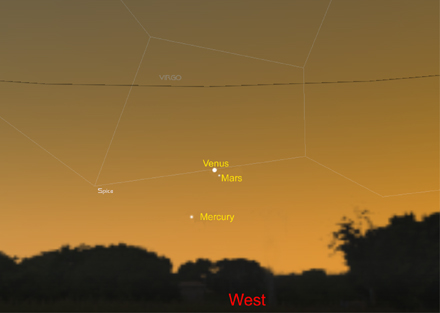
Close grouping of Venus, Mars and Mercury
Image: Stellarium/IM
13th September: A lunar occultation of Neptune in the early morning.
Image: Ian Morison
27th September: Saturn and a waning Crescent Moon
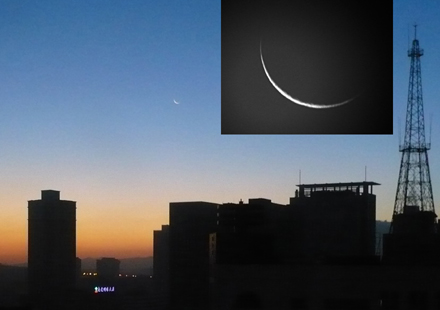
Wide angle and telescope images of a thin waning crescent Moon
Images: Ian Morison
Find M31 - The Andromeda Galaxy
Image: Stellarium/IM
1) Find the square of Pegasus. Start at the top left star of the square - Alpha Andromedae - and move two stars to the left and up a bit. Then turn 90 degrees to the right, move up to one resonably bright star and continue a similar distance again in the same direction. You should easily spot M31 with binoculars and, if there is a dark sky, you can even see it with your unaided eye. The photons that are falling on your retina left Andromeda well over two million years ago!
2) You can also find M31 by following the "arrow" made by the three rightmost bright stars of Cassiopeia down to the lower right as shown on the Chart. Good Hunting!
Observe the International Space Station

The International Space Station and Jules Verne passing behind the Lovell Telescope on April 1st 2008.
Image by Andrew Greenwood
Use the link below to find when the space station will be visible in the next few days. In general, the space station can be seen either in the hour or so before dawn or the hour or so after sunset - this is because it is dark and yet the Sun is not too far below the horizon so that it can light up the space station. As the orbit only just gets up the the latitude of the UK it will usually be seen to the south, and is only visible for a minute or so at each sighting. Note that as it is in low-earth orbit the sighting details vary quite considerably across the UK. The NASA website linked to below gives details for several cities in the UK. (Across the world too for foreign visitors to this web page.)
Note: I observed the ISS three times in the last week or so of July and was amazed as to how bright it has become.Find details of sighting possibilities from your location from: Location Index
See where the space station is now: Current Position
The Moon
The Moon at 3rd Quarter. Image, by Ian Morison, taken with a 150mm Maksutov-Newtonian and Canon G7.
| new | first quarter | full moon | last quarter |
| September 29th | September 7th | September 15th | September 22nd |
Some Lunar Images by Ian Morison, Jodrell Bank Observatory: Lunar Images
The Planets

A montage of the Solar System. JPL / Nasa

A Cassini image of Jupiter . Nasa
Jupiter is now at the lowest point of the ecliptic in the sky and will only rise to about 16 degrees elevation when it is in the south. Thus, sadly, this year our views of Jupiter from northern latitudes will be rather poor. Despite the low elevation, even a small telescope will show the Galilean Moons as they weave their way around it. Due to refraction, we see Jupiter at very slightly different elevations in the different colours of the spectrum, thus bluring the image. A cleaner image may seen if one observes through a narrow band filter such as a green filter or, even better, if you have an 8" scope or above with a filter like an OIII filter only letting a very narrow band of light through.

The planet Saturn. Cassini - Nasa
Saturn is in conjunction with the Sun on September 4, lying on the far side of the Sun so is not visible during the first two weeks of September, but it will reappear in the pre-dawn sky by month’s end and will then rise 2 hours before the Sun with a magnitude of +0.9. This is significantly less than it often appears as the rings will then be at an angle of just 4 degrees from edge on! As we move towards the end of the year, this angle will reduce until the rings are edge on to us and become invisible to us. Saturn is close to the thin crescent Moon on the 27th Serptember.

Messinger image of Mercury Nasa
See highlight above

A Hubble Space Telescope image of Mars.
Jim Bell et al. AURA / STScI / Nasa
Mars lies to the upper left of Venus at the beginning of the month very low in the western sky after sunset. At magnitude +1.7 and with an angular size of just 3.9 arc seconds it will probably need binoculars to pick it out.
See highlight above.

Venus showing some cloud structure
Venus can be seen very low in the west after sunset shining at magnitude -3.8 so it is possible to spot it without the use of binoculars. It is gradually moving further in angle from the Sun so will remain in the evening sky for longer after the Sun has set as the month progresses whilst its brightness increases fractionally to a magnitude of -3.9. It starts September with an angular size of 10.8 arc seconds and its disk is 92% illuminated. By the end of the month, the angular size has increased to 12 arc seconds but the percentage illuminated has dropped to 86%. These two effects tend to cancel out in the way they affect its apparent brightness which is why the brightness remains almost constant.
See highlight above.

Radar image showing surface features
Find more planetary images and details about the Solar System: The Solar System
The Stars
The Evening September Sky
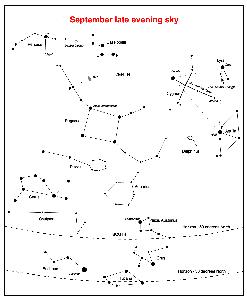
The September Sky in the south - early Sept:~11pm, late Sept:~10pm
This map shows the constellations seen towards the south in late evening. To the south in early evening moving over to the west as the night progresses is the beautiful region of the Milky Way containing both Cygnus and Lyra. Below is Aquilla. The three bright stars Deneb (in Cygnus), Vega (in Lyra) and Altair (in Aquila) make up the "Summer Triangle". East of Cygnus is the great square of Pegasus - adjacent to Andromeda in which lies M31, the Andromeda Nebula. To the north lies "w" shaped Cassiopeia and Perseus.
The constellations Lyra and Cygnus
This month the constellations Lyra and Cygnus are seen almost overhead as darkness falls with their bright stars Vega, in Lyra, and Deneb, in Cygnus, making up the "summer triangle" of bright stars with Altair in the constellation Aquila below. (see sky chart above)
Lyra
Lyra is dominated by its brightest star Vega, the fifth brightest star in the sky. It is a blue-white star having a magnitude of 0.03, and lies 26 light years away. It weighs three times more than the Sun and is about 50 times brighter. It is thus burning up its nuclear fuel at a greater rate than the Sun and so will shine for a correspondingly shorter time. Vega is much younger than the Sun, perhaps only a few hundred million years old, and is surrounded by a cold,dark disc of dust in which an embryonic solar system is being formed!
There is a lovely double star called Epsilon Lyrae up and to the left of Vega. A pair of binoculars will show them up easily - you might even see them both with your unaided eye. In fact a telescope, provided the atmosphere is calm, shows that each of the two stars that you can see is a double star as well so it is called the double double!

Epsilon Lyra - The Double Double
Between Beta and Gamma Lyra lies a beautiful object called the Ring Nebula. It is the 57th object in the Messier Catalogue and so is also called M57. Such objects are called planetary nebulae as in a telescope they show a disc, rather like a planet. But in fact they are the remnants of stars, similar to our Sun, that have come to the end of their life and have blown off a shell of dust and gas around them. The Ring Nebula looks like a greenish smoke ring in a small telescope, but is not as impressive as it is shown in photographs in which you can also see the faint central "white dwarf" star which is the core of the original star which has collapsed down to about the size of the Earth. Still very hot this shines with a blue-white colour, but is cooling down and will eventually become dark and invisible - a "black dwarf"! Do click on the image below to see the large version - its wonderful!

M57 - the Ring Nebula
Image: Hubble Space telescope
M56 is an 8th magnitude Globular Cluster visible in binoculars roughly half way between Alberio (the head of the Swan) and Gamma Lyrae. It is 33,000 light years away and has a diameter of about 60 light years. It was first seen by Charles Messier in 1779 and became the 56th entry into his catalogue.
Cygnus
Cygnus, the Swan, is sometimes called the "Northern Cross" as it has a distinctive cross shape, but we normally think of it as a flying Swan. Deneb,the arabic word for "tail", is a 1.3 magnitude star which marks the tail of the swan. It is nearly 2000 light years away and appears so bright only because it gives out around 80,000 times as much light as our Sun. In fact if Deneb where as close as the brightest star in the northern sky, Sirius, it would appear as brilliant as the half moon and the sky would never be really dark when it was above the horizon!
The star, Albireo, which marks the head of the Swan is much fainter, but a beautiful sight in a small telescope. This shows that Albireo is made of two stars, amber and blue-green, which provide a wonderful colour contrast. With magnitudes 3.1 and 5.1 they are regarded as the most beautiful double star that can be seen in the sky.

Alberio: Diagram showing the colours and relative brightnesses
Cygnus lies along the line of the Milky Way, the disk of our own Galaxy, and provides a wealth of stars and clusters to observe. Just to the left of the line joining Deneb and Sadr, the star at the centre of the outstretched wings, you may, under very clear dark skys, see a region which is darker than the surroundings. This is called the Cygnus Rift and is caused by the obscuration of light from distant stars by a lane of dust in our local spiral arm. the dust comes from elements such as carbon which have been built up in stars and ejected into space in explosions that give rise to objects such as the planetary nebula M57 described above.
There is a beautiful region of nebulosity up and to the left of Deneb which is visible with binoculars in a very dark and clear sky. Photographs show an outline that looks like North America - hence its name the North America Nebula. Just to its right is a less bright region that looks like a Pelican, with a long beak and dark eye, so not surprisingly this is called the Pelican Nebula . The photograph below shows them well.
Brocchi's Cluster An easy object to spot with binoculars in Gygnus is "Brocchi's Cluster", often called "The Coathanger",although it appears upside down in the sky! Follow down the neck of the swan to the star Alberio, then sweep down and to its lower left. You should easily spot it against the dark dust lane behind.

Brocchi's Cluster - The Coathanger
The constellations Pegasus and Andromeda

Pegasus and Andromeda
Pegasus
The Square of Pegasus is in the south during the evening and forms the body of the winged horse. The square is marked by 4 stars of 2nd and 3rd magnitude, with the top left hand one actually forming part of the constellation Andromeda. The sides of the square are almost 15 degrees across, about the width of a clentched fist, but it contains few stars visibe to the naked eye. If you can see 5 then you know that the sky is both dark and transparent! Three stars drop down to the right of the bottom right hand corner of the square marked by Alpha Pegasi, Markab. A brighter star Epsilon Pegasi is then a little up to the right, at 2nd magnitude the brightest star in this part of the sky. A little further up and to the right is the Globular Cluster M15. It is just too faint to be seen with the naked eye, but binoculars show it clearly as a fuzzy patch of light just to the right of a 6th magnitude star.
Andromeda
The stars of Andromeda arc up and to the left of the top left star of the square, Sirra or Alpha Andromedae. The most dramatic object in this constellation is M31, the Andromeda Nebula. It is a great spiral galaxy, similar to, but somewhat larger than, our galaxy and lies about 2.5 million light years from us. It can be seen with the naked eye as a faint elliptical glow as long as the sky is reasonably clear and dark. Move up and to the left two stars from Sirra, these are Pi amd Mu Andromedae. Then move your view through a rightangle to the right of Mu by about one field of view of a pair of binoculars and you should be able to see it easily. M31 contains about twice as many stars as our own galaxy, the Milky Way, and together they are the two largest members of our own Local Group of about 3 dozen galaxies.

M31 - The Andromeda Nebula
M33 in Triangulum If, using something like 8 by 40 binoculars, you have seen M31 as described above, it might well be worth searching for M33 in Triangulum. Triangulum is the small faint constellation just below Andromeda. Start on M31, drop down to Mu Andromedae and keep on going in the same direction by the same distance as you have moved from M31 to Mu Andromedae. Under excellent seeing conditions (ie., very dark and clear skies) you should be able to see what looks like a little piece of tissue paper stuck on the sky or a faint cloud. It appears to have uniform brightness and shows no structure. The shape is irregular in outline - by no means oval in shape and covers an area about twice the size of the Moon. It is said that it is just visible to the unaided eye, so it the most distant object in the Universe that the eye can see. The distance is now thought to be 3.0 Million light years - just greater than that of M31.
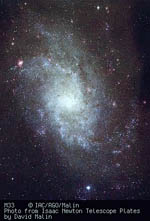
M33 in triangulum - David Malin
Advice on viewing the night sky
Advice on buying and using binoculars.
Advice on buying and using a telescope.
Observe the Astronomical A-List
How to observe some of the best objects in the heavens
A Website to help you find your way around the sky: Your Sky
An excellent Constellations Web site: The Constellations
An excellent Astronomy Web site: The Society for Popular Astronomy
Learn more about the Universe by studying with Jodrell Bank astronomers: The Jodrell Bank Distance Learning page

